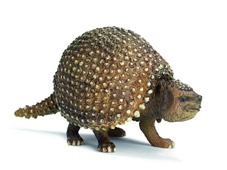Ancient Ancestor of Armadillos Found in the Andes
Early Glyptodont Remains Provides Clue to Glyptodont Origins
A team of American palaeontologists have recovered the remains of an ancient armoured mammal – a glyptodont from a remote fossil site high up in the Chilean Andes.
The fossils, part of the backbone, jaw and elements of the armoured shell that is so distinctive for this group, indicate that this is a new species, one of the earliest representatives of this mammal lineage. It has been named Parapropalaehoplophorus septentrionalis, a very long name for this animal which was relatively small compared to some of this group’s later representatives which could weigh more than one tonne.
The animal was named after another genus of these group Propalaehoplophorus, which was found in Argentina at a more southerly latitude. The species name – septentrionalis is from the Latin for northern so this new glyptodont’s name can be interpreted as“near to Propalaehoplophorus from the north”.
The American team worked at an altitude of 18,000 feet, making this site one of the highest fossil excavation sites in the world. They had to work in freezing conditions, high winds and the lack of oxygen in the air made the work exceedingly difficult. The fossil dates from the Miocene Epoch (18 million years ago), and although the fossils were found at an elevation in excess of 5,000 metres scientists believe that when this animal lived the land was much lower. This small herbivore weighed in at around 90 KGs and was about 1.2 metres long, it wandered around the grasslands that covered much of this part of the world in the Miocene. Earth movements that are pushing up the Andean mountains led the fossil remains to be found at such a high altitude
A Picture of a Typical Glyptodont

Picture credit: Everything Dinosaur
Glyptodont model here: Prehistoric Animal Models.
Co-leader of the expedition, John Flynn (Dean of the Richard Gilder Graduate School and a curator at the American Museum of Natural History); has stated that this fossil could indicate that the armoured-shelled glyptodonts could have originated in northern Chile, before diversifying across the rest of South America. The armour for each species of glyptodont tends to have a different pattern, the armour on P. septentrionalis for example, consisted of tiny, circular bumps.
The fossils were first located in 2004 during a field expedition to the Salar de Surire region of northern Chile. This site has yielded important information regarding the evolution of Miocene mammal groups. To date 18 animal species have been recovered from the site, collectively they have been called “Chucal fauna” and they represent part of the complex ecosystem that thrived on the grassy plains. As well as primitive relatives of modern armadillos (xenarthran mammals), remains of marsupials, rodents, and hoofed mammals (ungulates) have been discovered. The site has also yielded the ancient remains of prehistoric frogs (they look very much like modern frogs).
The last of the giant glyptodonts died out approximately 10,000 years ago, perhaps driven to extinction by a combination of changing climate, competition from other mammal species and hunting by humans.
Glyptodonts are certainly very enigmatic. There unusual shape and bizarre body armour makes them a popular prehistoric mammal. They have been included in our Natural History range of prehistoric mammal soft toys. An adult and a baby glyptodon have been designed. Unlike the dinosaur range, as these represent mammals they could be made more soft and fluffy.
The Soft Toy Glyptodon (Mother and Baby)
Picture credit: Everything Dinosaur
For prehistoric animal soft toys: Prehistoric Animal Soft Toys.


